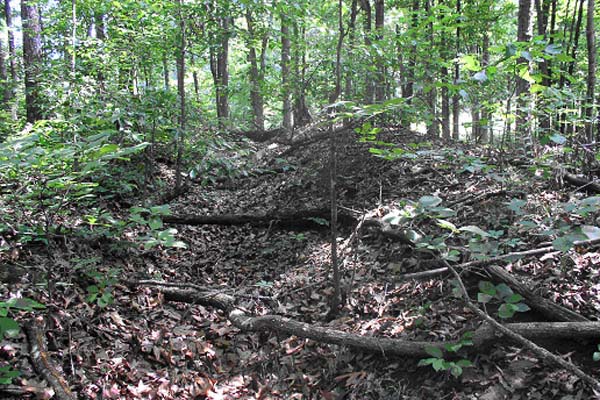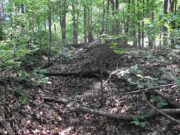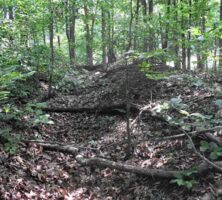Archaeology offers a unique perspective on the Civil War (1861-65), allowing archaeologists and historians to look at this defining event from a material perspective.
The Nature of Civil War Archaeology
In reconstructing the material context of the war, archaeologists study three main components: artifacts, features, and sites. Artifacts are man-made objects, such as bullets, pipe fragments, or uniform buttons. Features are similar to artifacts in that they are created by human hands, but unlike artifacts they cannot be physically separated from the landscape. Examples of features include a military trench or the remains of a soldier’s fire pit. Sites are defined as locations that contain a collection of artifacts and/or features, such as a battlefield or a fort. Civil War archaeologists look for the patterns of these three elements (often called the triad or trinity) as a means to interpret past behavior and activities.
Archaeologists place the triad of elements into a contextual framework through the study and application of letters, diaries, official military records, and other primary historical documents. An archaeological approach to the Civil War allows a wider array of wartime participants to enter the historical picture. Often the perspective of the common soldier, for example, can be presented only from an archaeological standpoint, given his more marginal representation in the written historical record.
Archaeological investigations of Georgia’s Civil War past may involve a number of different types of sites, including battlefields, training camps, bivouacs (encampments), earthen fortifications, masonry fortifications, and other strictly military features on the landscape. Other types of sites, such as mills, farms, and railroads, allow archaeological researchers to study aspects of the war that are not strictly military in origin and thus to glean a more complete picture of the war and how it affected all citizens, military and civilian.

Origins of Civil War Archaeology in Georgia
One of the first archaeological investigations into the Civil War in Georgia was undertaken in the 1930s at Kennesaw Mountain in Cobb County. Archaeologist Charles Fairbanks undertook the documentation and limited excavation of Confederate earthworks at the battle site on top of the mountain. Fairbanks’s early study was pioneering, as few archaeologists at the time recognized the value in investigating the Civil War from an archaeological perspective. Instead, most archaeologists focused their attention on much older sites. Not until the passage of the National Historic Preservation Act (NHPA) of 1966 did Civil War archaeology expand.
Section 106 of NHPA provides for the recording of archaeological and historic resources in an area to be disturbed by a federal undertaking (which would include local undertakings using federal funds, such as a road improvement project). The act’s passage drew attention to Civil War sites as not only historic but also archaeological resources and led to numerous sites throughout the state being recorded and investigated for the first time by archaeologists. With the construction of MARTA during the 1970s, a number of Atlanta sites associated with the 1864 Battle of Atlanta and the Battle of Ezra Church, both of which took place during the Atlanta campaign, were studied and excavated. Previously, the sites had been known only to amateur collectors.
Archaeologists versus Relic Collectors
The practice of Civil War relic collecting began during the war itself and often took place immediately following a particular engagement, when local civilians would search the battlefield for souvenirs. The collection of such artifacts or “relics” has been and continues to be a popular pastime but differs from archaeology in both approach and intent. Now illegal on federal and most state property, the practice of relic collecting has led to an inherent bias in what remains of the archaeological record at Georgia’s Civil War battlefields. Some relic collectors have aided archaeological studies greatly, however, by volunteering their knowledge and time to a common interest in the state’s Civil War history.
Relic collectors introduced the metal detector, a tool that archaeologists were slow to embrace, in the late 1940s and 1950s. Collectors used surplus detectors, originally used to detect landmines during World War II (1941-45), to look for artifacts on Civil War sites. Considered beneath the standards of the discipline, this practice was stigmatized for many years by the archaeological community. Some studies during the 1970s, such as the MARTA project, made attempts at using metal detectors but with limited application.
The pioneering National Park Service investigations of the 1980s at the Little Bighorn Battlefield in Montana demonstrated the capabilities of metal detectors in the hands of archaeologists. Recent investigations at Georgia’s Civil War battlefields have incorporated the results of the Little Bighorn study, leading to a methodology that not only is an effective means of data acquisition but also has become the standard approach to Civil War battlefield research.
New Directions for Civil War Archaeology
Civil War archaeology in Georgia continues to utilize new technologies and approaches in order to better interpret site and artifact patterns. Many current studies use geographic information systems (GIS) technology, which allows researchers to project maps from the Civil War period into a modern mapping program. With GIS technology, researchers can pinpoint Civil War features on Georgia’s modern landscape. This technology can also help with the monitoring of Civil War site preservation, which continues to be an ongoing struggle for the state. (In 1993 the state legislature established the Georgia Civil War Commission to coordinate the preservation and promotion activities of battle sites around the state.) Researchers today use such noninvasive technologies as ground-penetrating radar to help identify features long lost to urbanization.
Recent investigations into the Civil War archaeology of Georgia include examinations of the site of the Battle of Chickamauga in north Georgia and Tybee Island’s coastal fortifications, as well as studies of the interaction between civilians and soldiers at the site of the Battle of Pickett’s Mill in Paulding County. In 2010 archaeology students at Georgia Southern University in Statesboro discovered the site of Camp Lawton, the prison camp built late in the war to relieve overcrowding at Andersonville Prison in Macon County. Because it was previously undisturbed, the Camp Lawton site, located near Millen, has provided excavators with a fuller and more varied collection of both artifacts and features than those found at well-established sites that have been subject to plunder over the years.





